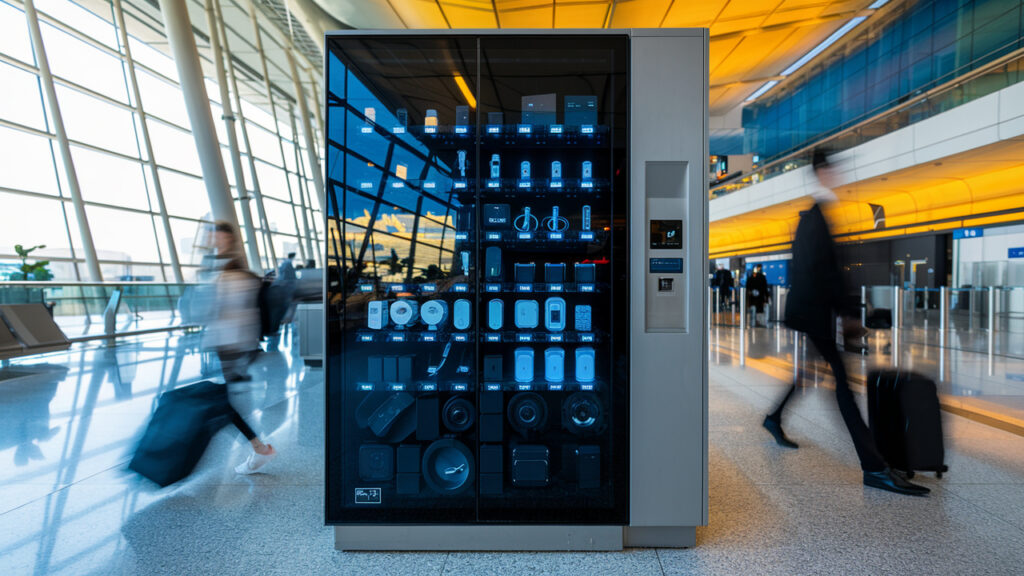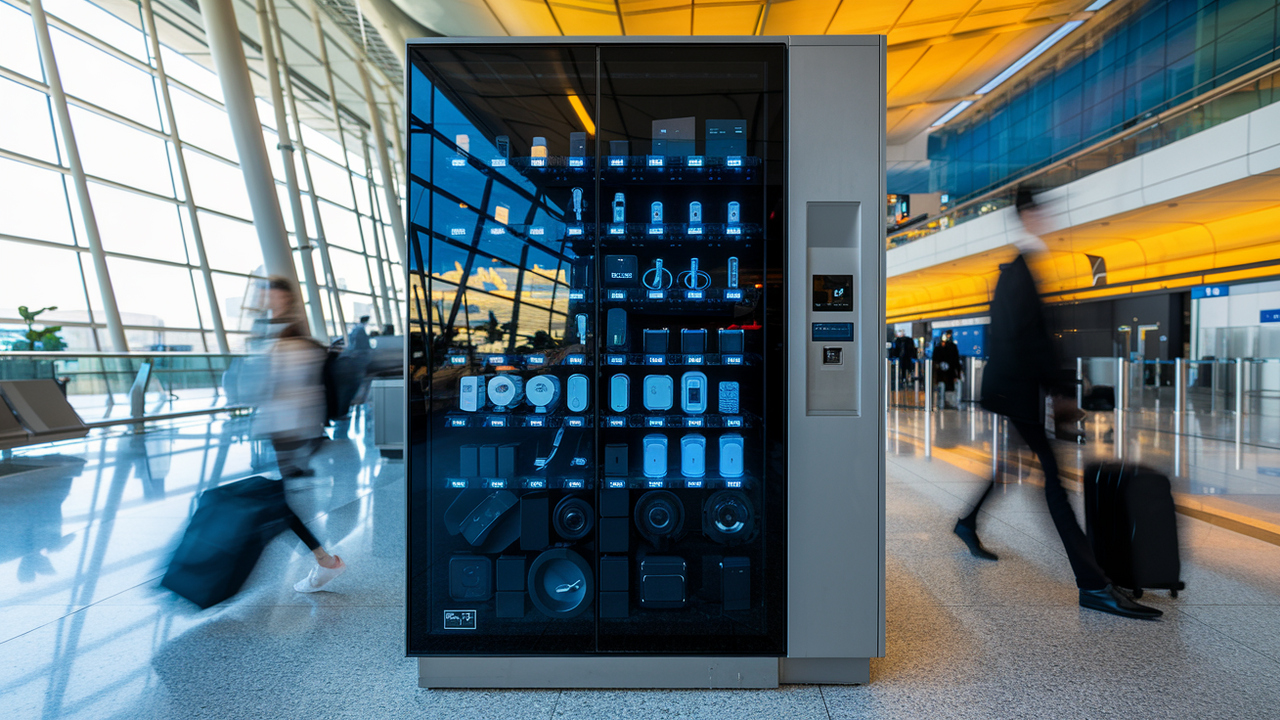Best USB and Tech Vending Machines for Airports or Gyms
When I started looking into niche vending opportunities, one of the best-performing categories I stumbled upon was USB and tech accessories vending machines. If you’ve ever forgotten your charger at the airport or needed earbuds before a gym session, you already know how valuable these machines can be.
In this post, I’ll walk you through the best USB and tech vending machines for airports, gyms, and other high-foot-traffic areas—and show you how these machines can generate real profits with low maintenance and smart product selection.

Table of Contents
Why Tech Vending Machines Work So Well
People will pay a premium for convenience, especially when they’re in a pinch. At airports, travelers forget chargers, lose earbuds, or need power banks while waiting for flights. In gyms, people realize they left their headphones at home or their Apple Watch died halfway through a workout. That’s where USB and tech vending machines come in.
Unlike snacks, tech items don’t expire and often have higher margins. With the right pricing and location, these machines can bring in $500–$1,500+ per month, depending on foot traffic.
What to Stock in USB & Tech Vending Machines
Here’s what I typically load into my tech vending machines:
- USB-A and USB-C charging cables
- Lightning cables (iPhone)
- Wireless earbuds
- Power banks / portable chargers
- Phone holders or pop sockets
- Watch bands (for Apple & Samsung)
- Wall adapters
- Screen wipes or microfiber cloths
- Travel plug adapters (especially at airports)
These are all items that people buy impulsively when they forget theirs—and they’re willing to pay $10 to $30 for the convenience.
Best USB and Tech Vending Machines (Compact & Modern)
✅ Seaga INF5C Combo Vending Machine
This machine is compact and offers configurable shelves that can handle small tech products securely. It’s ideal for high-traffic indoor locations like gym entrances or gate lounges in airports. Credit card-ready and easy to manage.
✅ VENDOMAX Smart Compact Vending Machine with Touchscreen
Touchscreen interface and credit card compatibility out of the box. This one looks sleek and is great for more upscale gyms or tech-focused airport terminals. Also allows you to upload product images or videos.
✅ Jofemar Compact Mini Vend – Adjustable Coils
A more affordable option that fits nicely in small spaces. I’ve used this at a yoga studio that sold phone chargers and screen cleaners. You can adjust the coil tightness to hold small boxes securely.
✅ YJINGRUI Small Item Vending Machine – Grid Locker Type
This locker-style machine is perfect for selling more expensive items like wireless earbuds, smartwatch bands, or Bluetooth speakers. Each unit opens individually, and it’s built to reduce theft risk.
Best USB and Tech Products to Vend (with Links)
✅ Anker USB-C to USB-A Cable, 2-Pack – Durable & Fast Charging
These are affordable, high-quality cables that vend easily and sell fast in gym and airport machines.
✅ Apple MFi Certified Lightning Cables – 3 Pack
Perfect for iPhone users. These sell extremely well in airports, especially near iPhone-dominant regions.
✅ INIU Portable Charger – Slim Power Bank, Fast Charge
Reliable, compact, and easy to vend. Power banks are a best-seller at airports and work even better when flights are delayed or terminals lack outlets.
✅ Tozo Wireless Earbuds with Charging Case
These earbuds come in a compact case and fit perfectly in locker-style vending machines. People love the instant fix when they forget theirs.
✅ Universal International Travel Plug Adapter
Travelers who forget their adapters will pay top dollar. This product works especially well at international terminals or airports with lots of overnight flights.
Setup Tips for Airport or Gym Locations
When I place tech vending machines, I focus on entrance points, lounges, waiting areas, or locker rooms—anywhere people pause and realize they’re missing something. Here’s what I recommend:
- Use glass-front machines so customers can see the items clearly
- Label each product with its use: “iPhone Charger,” “USB-C Cable,” etc.
- Keep a mix of price points ($5–$40) to accommodate impulse and emergency purchases
- Stock extra inventory for weekends and holidays
- Use cashless payment options only—almost no one uses coins for tech products
Maintenance and Profit Tips
Unlike snack machines, you don’t need to restock tech machines weekly. I typically check mine once every 2–3 weeks, depending on volume. Since most tech items have a high price point and long shelf life, they don’t require as much attention.
Your margins are higher too. You can buy cables for $2–$3 in bulk and sell them for $12–$18. Same with earbuds—you can stock a $20 item and sell it for $35+ easily. That’s why one good tech machine can often outperform two snack machines side-by-side.
Final Thoughts
If you’re looking to branch out from snacks and drinks, USB and tech vending machines are an underrated opportunity—especially in airports, gyms, and co-working spaces. These machines offer high-ticket items, long shelf life, and premium margins with minimal upkeep.
Whether you’re just starting or looking to diversify your vending machine fleet, this is a niche you don’t want to overlook.
One of the things I love most about tech vending is the low spoilage and inventory loss. Unlike snacks or drinks, tech products don’t expire. I’ve had cables and power banks sitting in machines for months and still selling at full price. That stability makes this niche more passive and predictable in the long run.
Airport locations especially benefit from last-minute needs. I’ve seen customers walk up visibly frustrated—phone at 5% battery, no charger, and a two-hour layover ahead. That urgency turns into immediate sales, even if the price is double what they’d pay at a store. It’s all about timing and accessibility.
Another trick I’ve used is adding bundles to increase the cart value. For example, I’ve stocked “Travel Power Kits” that include a wall adapter, USB cable, and international plug—all packed in a small zip bag and sold as a single item. These bundles sell surprisingly well, especially with tourists or business travelers.
In gyms, people tend to purchase lower-cost accessories like earbuds, watch straps, or charging cables. I avoid stocking high-end products in those locations since theft risk is higher and the average price point tends to be lower. Instead, I focus on fast-moving essentials.
When setting pricing, I always factor in the “emergency premium”—the price people are willing to pay when they forgot something important. I might charge $15 for a cable that costs me $3.99, and customers still feel like it’s worth it because they need it now.
If you’re working with gyms, ask about placing your machine near check-in desks or locker areas, where members have that “oh no, I forgot my headphones” moment. Those impulse purchases happen fast and often lead to repeat business.
Another good idea is to offer QR codes on the machine that link to product guides or brand info. Some customers want to know, “Will this cable work with my phone?” or “Are these earbuds waterproof?” Linking to Amazon listings or branded product pages gives them peace of mind before buying.
In some locations, I’ve also added a few lifestyle tech items, like mini phone tripods or magnetic car mounts. These don’t move as quickly but create the sense that your machine isn’t just for emergencies—it’s a full-on convenience tech shop.
Tech machines also work great for brand customization. I’ve designed a few machines with my logo, backlit LED signage, and custom shelving labels that make them look like mini Apple stores. The aesthetic alone can boost your perceived value and help build trust.
For payment systems, I highly recommend using Nayax or PayRange for tech vending. These systems allow for credit/debit, contactless, and mobile wallet payments, which is crucial when you’re selling higher-ticket items. No one wants to insert $30 worth of quarters for a power bank.
Be sure to track product performance per location. In airports, iPhone products dominate. In gyms, USB-C and budget earbuds sell better. Your inventory strategy should reflect the tech habits of your audience—and that can vary greatly by region and venue type.
Lastly, always be willing to test and rotate products. I thought smartwatches would sell well in one gym, but they barely moved. Meanwhile, $12 charging cables were selling out weekly. Pay attention to what’s actually moving, not what you think people should buy.

